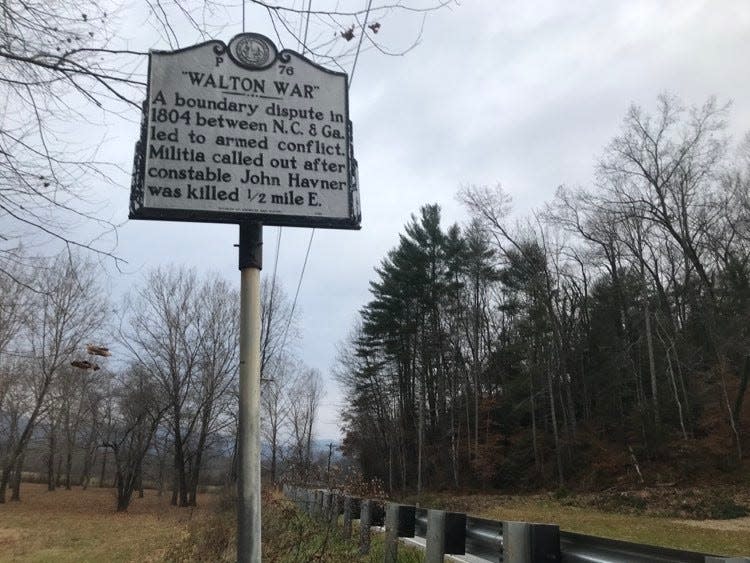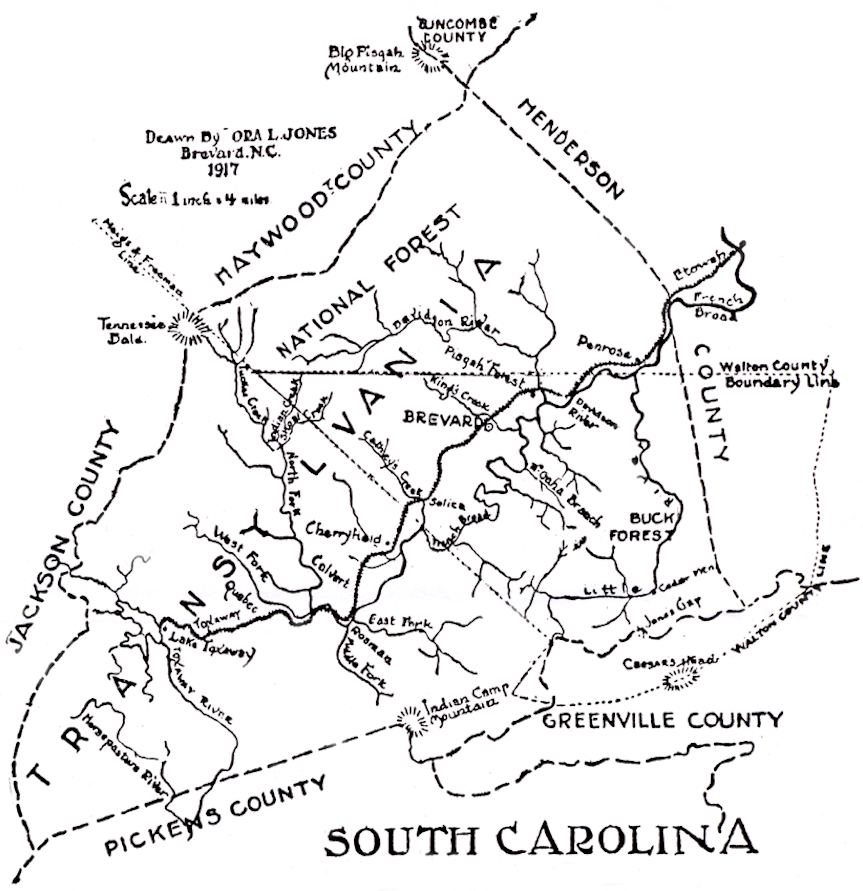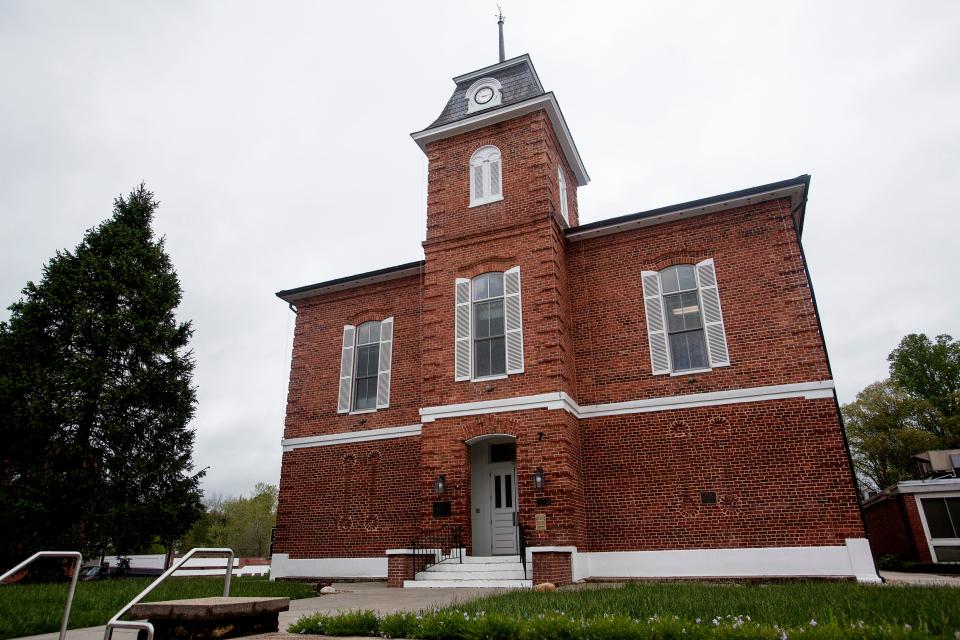Walton War: The North Carolina-Georgia border clash that's maybe, not quite, totally over

- Oops!Something went wrong.Please try again later.
The Walton War was waged over land no state initially wanted.
But 200 years after its last “battle," this peculiar clash between North Carolina and Georgia still resonates in a part of Appalachia where border conflicts aren’t a thing of the past.
In 1787, South Carolina ceded a 12-mile section of the Blue Ridge Mountains to the fledgling United States federal government. The U.S. gave the land to the Cherokees before retaking it in a 1798 treaty.
At the start of the 19th century, the area was an anomaly; part of the United States but not part of any state. None of its neighbors — North Carolina, South Carolina, or Georgia — would claim it. Today, the land belongs to Western North Carolina’s Transylvania County, but back then, it was nicknamed “the Orphan Strip.”
Outlaws and suspect borders
For a time, the Orphan Strip existed as a no man’s land.
Without state governments, the area attracted outlaws, which dissuaded neighbors from adopting it. In 1800, local settlers petitioned to join South Carolina, but South Carolina refused.
Yet as American settlers pushed westward, the region's state governments began reconsidering the Orphan Strip.
In 1802, Georgia struck a deal with the federal government: In exchange for the Orphan Strip, Georgia relinquished control of lands to its west (which became Mississippi and Alabama). Georgia named its new addition Walton County, after George Walton, a signer of the Declaration of Independence. An 1803 census showed Walton County was home to 424 white residents and 30 enslaved Black residents.
Around this time, North Carolina officials grew interested in this area too. As settlers from both states entered, North Carolina declared it to be part of its Buncombe County.

It was difficult to say which state actually had a rightful claim to the land. The federal government had set the North Carolina-Georgia boundary at the 35th parallel, but rudimentary land surveying and the region's uneven terrain made it hard to accurately locate the parallel.
“The boundaries back then were terrible,” said Yvonne McCall-Dickson, a historian in Transylvania County whose paternal ancestor, Samuel McCall, lived in the disputed area at the time. “Especially in the mountains, it was very hard to survey.”
This set the stage for the first skirmish of the Walton War.
More: Spooky shelves: What the most stolen library book in Buncombe County says about Asheville
A county contested
In late 1804, Walton County officials began evicting settlers who held North Carolina land grants. When one of the settlers, a constable named John Havner, resisted eviction, a fight broke out at his home near the French Broad River. In the melee, Havner was struck with the butt of a rifle and died.
North Carolina responded with force, deploying a militia of more than 70 men to arrest 10 Walton officials connected to Havner’s death. The officials were taken to a jail in Morganton, North Carolina, from which they escaped.
After the arrests, an emboldened North Carolina turned the tables by evicting settlers with Georgia land grants.
To settle the unrest, the two states agreed to commission a new border survey. The presidents of the University of Georgia and the University of North Carolina were chosen to oversee the process. Using sextants and the sun, surveyors mapped out the 35th parallel and found Walton County lay north of the line, making it part of North Carolina.
“This was a matter of great astonishment to the Georgians,” wrote historian Cal Carpenter in his 1979 book “The Walton War and Tales of the Great Smoky Mountains.”

Rejecting the survey, Georgia maintained its Walton County government. According to a 2003 article in the Atlanta Journal-Constitution, Georgia and North Carolina jointly governed the contested area for a period around 1808, operating two court systems, two tax collectors, and two sheriffs. It wasn't sustainable.
In 1811, the Walton War once more turned hot. Tired of Georgia’s persisting claims to the land, North Carolina sent 200 troops to drive out the settlers from the south. The soldiers met armed Georgia officials near the modern-day city of Brevard and pushed the Georgians back in two separate confrontations.
Some reported as many as 14 men were killed in these clashes, though others question whether anyone besides John Havner in 1804 died during the Walton War.
“As far as my research shows, there was only the one fatality," said Martin Reidinger, who, as a UNC student in the early 1980s, published a research paper on the Walton War (Reidinger now serves as the chief judge of the United States District Court for the Western District of North Carolina.)
After another land survey reconfirmed its place above the 35th parallel, Walton County disbanded, and in 1818, Georgia formed a new Walton County 150 miles to the south.
Yet, the region's border conflicts lingered into the next century. And the one after that.
NC education: Fewer NC rural students go to college. Educators are working to close that gap
Modern border fights
In 1971, the border issue resurfaced when the Georgia legislature declared its state still had a legitimate claim to the one-time Orphan Strip.
The argument was unchanged from the early 1800s: Georgia lawmakers argued its northern borders with North Carolina and Tennessee didn’t align with the 35th parallel.
Some Georgia officials called for the issue to be taken to the United States Supreme Court.
North Carolina responded in a direct, albeit amused, matter. The state's General Assembly authorized then-Gov. Bob Scott to mobile the national guard to “protect, defend, and hold inviolate the territorial border of North Carolina against the spurious claims by the State of Georgia.”
In another tongue-in-cheek response, the General Assembly called on Scott to "build fortifications" along the Georgia border.

This put the matter to bed, at least for several decades. But into the 21st century, Georgia has continued to dispute its northern boundaries.
In 2013, the Georgia Senate formally contested its border with Tennessee. Then in 2019, the Georgia legislature sought to create a tri-state commission to remap its borders with North Carolina and Tennessee. It called for the commission to rectify “a flawed survey” from the early 1800s that “erroneously marks the 35th parallel.” The commission never formed.
The reason Georgia is so particular about the location of its borders comes down to water access. The Tennessee-Georgia border currently runs a few hundred feet below sections of the Tennessee River. If the border were drawn to the north, as some Georgians believe it should, then the Peach State would have another freshwater source to supply to its growing population.
Georgia may be correct in asserting its northern borders don't align with the 35th parallel, said Bart Crattie, a land surveyor who lives on the Georgia side of Lookout Mountain, a town near the Georgia-Tennessee border.
But even if Georgia is technically right, Crattie doesn’t see his state’s borders with Tennessee or North Carolina ever being adjusted.
“There's too much precedent,” he said. “It won't happen.”
More Transylvania County coverage: 'No Dollar in the Holler': NC cities strive to halt new dollar stores in their backyards
Brian Gordon is a statewide reporter with the USA Today Network in North Carolina. Reach him at bgordon@gannett.com or on Twitter @skioutbriout.
This article originally appeared on Asheville Citizen Times: Walton War with North Carolina and Georgia echoes today's border fight

